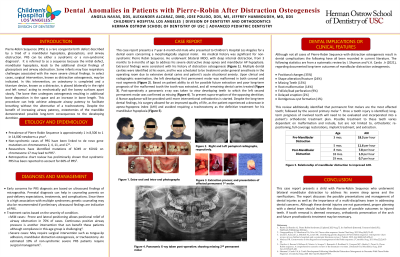Syndromes/Craniofacial Anomalies
476 - Dental Anomalies in Patients with Pierre-Robin After Distraction Osteogenesis


Angela Navas, DDS (she/her/hers)
Dental Resident
University of Southern California
University of Southern California
Los Angelea, California, United States- AA
Alexander Alcaraz, DMD
University of Southern California
- AA
Alexander Alcaraz, DMD
Program Director
University of Southern CA
Los Angeles, California, United States
Presenting Author(s)
Co-Author(s)
Program Director(s)
Introduction: Distraction osteogenesis is the process of mechanically elongating a bone. An osteotomy is completed and a titanium device, known as a distractor, is placed acting to mechanically pull the boney surfaces apart slowly. The bone then undergoes osteogenesis resulting in additional bone deposition in the space and an increase in bone length. This surgical technique has been used in patients with Pierre-Robin sequence, the condition described by a triad of a mandibular hypoplasia, glossoptosis, and airway obstruction. Distraction Osteogenesis is utilized in these patients to address severe airway obstruction due to mandibular hypoplasia to relieve anatomical airway stenosis.
Case Report: This case report describes the dental management of a child with Pierre-Robin Sequence who underwent bilateral mandibular distraction osteogenesis (MDO) during infancy. A 7 year-3-month-old male presented to Children’s Hospital Los Angeles for a dental exam concerning a morphologically atypical molar. This patient underwent bilateral MDO, with deep internal distraction, from 3 months to 6 months of age to address his severe obstructive sleep apnea and mandibular AP hypoplasia. Upon clinical and radiographic examination, the left developing first permanent molar presented as malformed and the left second permanent molar was identified as missing. Long-term evaluation and treatment planning are important in dental management in these patients, as future prosthetics may be necessary to restore these patient’s dentition to ideal function.
Identify Supporting Agency and Grant Number:

.jpg)